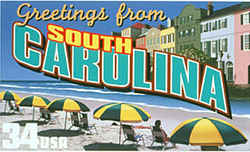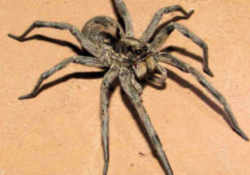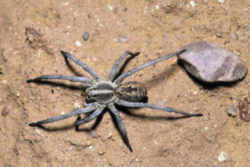
South Carolina Symbols
South Carolina State Spider
Carolina Wolf Spider

(Hogna carolinensis)
Adopted on July 21, 2000.
The Carolina Wolf Spider, (Hogna carolinensis,) was designated as South Carolina official State Spider by Act No. 389.
Then, on July 21, 2000, when Governor Mark Sanford signed House Bill No. 4277 into law, the "Richardson Waltz" became South Carolina's official waltz and the Carolina wolf spider became South Carolina's official spider. A third grade student, Skyler B. Hutto, from Sheridan Elementary School in Orangeburg help to ensure that South Carolina had an official state spider.
South Carolina State Spider: Carolina Wolf Spider

Spiders are arachnids which can be readily recognized by the presence of 8 legs (true for all arachnids including ticks, mites and daddylong legs) and the presence of spinnerets (true only for spiders). Not all spiders build webs (in fact, nearly half do not!) but all spiders do use silk. Most wolf spiders do not build webs, but they use silk to wrap their egg cases and to leave draglines or safety lines. Some males can follow a female's dragline.
Description
The largest North American wolf spider is Hogna carolinensis, the carolina wolf spider. This gray, to brownish, spider with dark undersides takes one and a half years to reach maturity and may live as long as three years. Wolf spiders are large, with a 1 inch (25 mm) body length; like tarantulas, they live in burrows. Wolf spider burrows can be differentiated from tarantula burrows by the turret of silk and twigs that extends vertically from the wolf spider's hole. The wolf spider can be from gray to dark brown with distinctive peach or orange coloration on the front of the chelicerae.
Distribution and Habitat
Throughout the United States and southern Canada in habitats ranging from desertscrub to woodlands.
Diet
Wolf spiders are expert and vigorous hunters. Spiderlings eat flightless fruit flies, and pinhead crickets. Adults eat crickets, and other large insects.
Ecology
They are typically active from March through October, when their green eye shine can be easily seen as they cross roads at night. The eye shine is caused by a tapetum in the eye which reflects light rays back through the eye retina and probably enhances the spider's night vision. Wolf spiders are primarily nocturnal predators and are rarely seen during the day.
Life History
Adult males can be found wandering throughout the summer rainy season, presumably searching for mates. The male must give the female appropriate signals when he finds her, to avoid being perceived as a threat. He does this by tapping his legs in a particular fashion. He also drums with his palps, and in a procedure called stridulation, he produces sounds by scraping the palp against itself. After the female lays eggs, she carries the egg case with her wherever she goes, attached to her spinnerets. The female has between 100 and 600 possible young in her egg sac. Sometimes she suns the egg case, sticking her rump, with egg case attached, outside the burrow entrance. After the spiderlings are old enough, after about a month they help them escape from the sac and climb onto the mother's back, holding onto specialized hairs. After another month, they disperse, sometimes by ballooning. A female wolf spider may live up to 3 years, with the males lifespan being much shorter.
South Carolina Act No. 389
Act No. 389
(A389, R459, H4277)
AN ACT TO AMEND THE CODE OF LAWS OF SOUTH CAROLINA, 1976, BY ADDING SECTIONS 1-1-667 AND 1-1-701 SO AS TO DESIGNATE CERTAIN STATE EMBLEMS OR SYMBOLS.
Be it enacted by the General Assembly of the State of South Carolina:
PART I
Richardson Waltz Act
SECTION 1. Sections 1 through 4 of this act are known and may be cited as the "Richardson Waltz Act".
Findings
SECTION 2. The General Assembly finds that:
(1) The Richardson family, descendants of General Richard Richardson (1704-1780) who came from Virginia as a surveyor to settle in South Carolina,
is known for its great love of music and dancing.
(2) Many balls were held as social entertainment for family and friends from far and wide, and the melody of a favorite waltz for dancing was one which
was "originated" by a family member who played "by ear".
(3) This melody, known as "The Richardson Waltz", still lives today, having been handed down "by ear" from generation to generation but had never been
written until 1985, when it was arranged by Mary S. Richardson Briggs.
(4) Mrs. W. M. Richardson of Orangeburg planted the seed for the preservation of "The Richardson Waltz" many years ago, and Mrs. H. B. Richardson of
Summerton helped hand it down and preserve it for posterity.
(5) This waltz is a beautiful and soulful melody, is a memento of the musical tradition of the Richardson family, has for many generations played an
unofficial but important role in the musical history of South Carolina, and is deserving of designation as the Official State Waltz.
(6) A bill to designate "The Richardson Waltz" as the official waltz was sponsored by Representatives C. Alexander Harvin III, Elsie Rast Stuart, Jimmy
C. Bales, Lynn Seithel, Jackson S. "Seth" Whipper, Becky Meacham-Richardson, Harry L. Ott, Jr., John Milton "Jake" Knotts, Jr., and Walton J. McLeod.
Official state waltz
SECTION 3. Chapter 1, Title 1 of the 1976 Code is amended by adding:
"Section 1-1-667. 'The Richardson Waltz' is designated as the official state waltz."
Distribution by Code Commissioner
SECTION 4. The Code Commissioner shall distribute copies of Part I of this act to any interested persons including the members of the Richardson family
and the Daughters of the American Revolution.
PART II
Carolina Wolf Spider Act
SECTION 5. Sections 5 through 8 of this act are known and may be cited as the "Carolina Wolf Spider Act".
Findings
SECTION 6. The General Assembly finds that:
(1) The state emblems and symbols adopted by the General Assembly and listed in the South Carolina Legislative Manual are an excellent educational
resource for students of this State.
(2) After reading in the Legislative Manual about the existing state symbols and emblems, Skyler B. Hutto, a third grade student at Sheridan Elementary
School in Orangeburg, noted that there was no official state spider and suggested that the Carolina Wolf Spider be given that designation.
(3) A bill to designate the Carolina Wolf Spider as the official state spider was sponsored by Senator Brad Hutto.
(4) Skyler Hutto has worked diligently to pursue this designation for the Carolina Wolf Spider.
(5) His schoolmates and teachers have followed the progress of the legislation with interest.
(6) Through this experience, the students have learned both about spiders and about how a bill becomes a law, which has enhanced the third graders'
study of South Carolina history.
Official state spider
SECTION 7. Chapter 1, Title 1 of the 1976 Code is amended by adding:
"Section 1-1-701. The 'Carolina Wolf Spider', Hogna carolinensis, is designated as the official state spider."
Distribution by Code Commissioner
SECTION 8. The Code Commissioner shall distribute copies of Part II of this act to any interested persons including Skyler B. Hutto and the students
and teachers of the Sheridan Elementary third grade class.
PART III
Time effective
SECTION 9. This act takes effect upon approval by the Governor.
Ratified the 22nd day of June, 2000.
Approved the 21st day of July, 2000.
South Carolina Law
The law designating the"Carolina Wolf Spider" as the official South Carolina state spider is found in the South Carolina Code of Laws, Title 1, Chapter 1, Article 9, Section 1-1-701.
Title 1 - Administration of the Government
CHAPTER 1. GENERAL PROVISIONS
ARTICLE 9. STATE EMBLEMS, PLEDGE TO STATE FLAG, OFFICIAL OBSERVANCES
SECTION 1-1-701.
SECTION 1-1-701. Official State spider.
The "Carolina Wolf Spider", Hogna carolinensis, is designated as the official state spider.
Taxonomic Hierarchy: Carolina Wolf Spider
Kingdom: Animalia - animals
Phylum: Arthropoda - arthropods
Class: Arachnida - spiders, harvestmen, scorpions, mites, etc.
Order: Araneae --spiders
Family: Lycosidae
Genus: Hogna
Species: Hogna carolinensis







